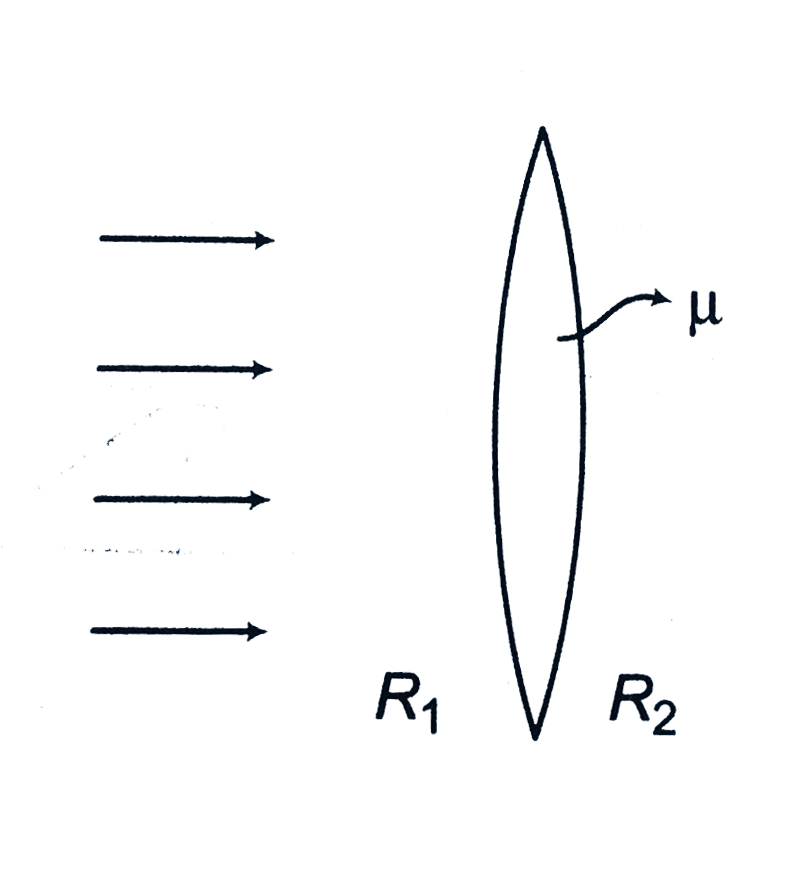Lenses are constructed by a material of refractive indeic 1'50. The magnitude of the radii of curvature are 20 cm and 30 cm. Find the focal lengths of the possible lenses with the above specifications.
The correct Answer is:A, B, C, D
To solve the problem of finding the focal lengths of the possible lenses constructed from a material with a refractive index of 1.5 and given radii of curvature of 20 cm and 30 cm, we will use the lens maker's formula. The lens maker's formula is given by:
1f=(μl−1μm)(1R1−1R2)
Where:
- f is the focal length of the lens,
- μl is the refractive index of the lens material,
- μm is the refractive index of the medium (1 for air),
- R1 is the radius of curvature of the first surface,
- R2 is the radius of curvature of the second surface.
Step 1: Identify the lens types and their configurations
We will consider four possible lens configurations:
1. Double Convex Lens (Convex-Convex)
2. Concave-Convex Lens (Convex-Concave)
3. Double Concave Lens (Concave-Concave)
4. Concave-Convex Lens (Concave-Convex)
Step 2: Calculate the focal length for each lens type
Case 1: Double Convex Lens
- For a double convex lens, R1=+20cm and R2=−30cm.
- Using the lens maker's formula:
1f=(1.5−11)(120−1−30)
=0.5(120+130)
Calculating 120+130:
=3+260=560=112
Thus,
1f=0.5⋅112=124
So, f=24cm.
Case 2: Concave-Convex Lens
- For a concave-convex lens, R1=+20cm and R2=+30cm.
- Using the lens maker's formula:
1f=(1.5−11)(120−130)
Calculating 120−130:
=3−260=160
Thus,
1f=0.5⋅160=1120
So, f=120cm.
Case 3: Double Concave Lens
- For a double concave lens, R1=−20cm and R2=+30cm.
- Using the lens maker's formula:
1f=(1.5−11)(−120−130)
Calculating −120−130:
=−(3+260)=−560=−112
Thus,
1f=0.5⋅−112=−124
So, f=−24cm.
Case 4: Concave-Concave Lens
- For a concave-concave lens, R1=−20cm and R2=−30cm.
- Using the lens maker's formula:
1f=(1.5−11)(−120−−130)
Calculating −120+130:
=−3−260=−160
Thus,
1f=0.5⋅−160=−1120
So, f=−120cm.
Summary of Focal Lengths
1. Double Convex Lens: f=+24cm
2. Concave-Convex Lens: f=+120cm
3. Double Concave Lens: f=−24cm
4. Concave-Concave Lens: f=−120cm
- f is the focal length of the lens,
- μl is the refractive index of the lens material,
- μm is the refractive index of the medium (1 for air),
- R1 is the radius of curvature of the first surface,
- R2 is the radius of curvature of the second surface.
We will consider four possible lens configurations:
1. Double Convex Lens (Convex-Convex)
2. Concave-Convex Lens (Convex-Concave)
3. Double Concave Lens (Concave-Concave)
4. Concave-Convex Lens (Concave-Convex)
- For a double convex lens, R1=+20cm and R2=−30cm.
- Using the lens maker's formula:
1f=(1.5−11)(120−1−30)
=0.5(120+130)
Calculating 120+130:
=3+260=560=112
Thus,
1f=0.5⋅112=124
So, f=24cm.
- For a concave-convex lens, R1=+20cm and R2=+30cm.
- Using the lens maker's formula:
1f=(1.5−11)(120−130)
Calculating 120−130:
=3−260=160
Thus,
1f=0.5⋅160=1120
So, f=120cm.
- For a double concave lens, R1=−20cm and R2=+30cm.
- Using the lens maker's formula:
1f=(1.5−11)(−120−130)
Calculating −120−130:
=−(3+260)=−560=−112
Thus,
1f=0.5⋅−112=−124
So, f=−24cm.
- For a concave-concave lens, R1=−20cm and R2=−30cm.
- Using the lens maker's formula:
1f=(1.5−11)(−120−−130)
Calculating −120+130:
=−3−260=−160
Thus,
1f=0.5⋅−160=−1120
So, f=−120cm.
1. Double Convex Lens: f=+24cm
2. Concave-Convex Lens: f=+120cm
3. Double Concave Lens: f=−24cm
4. Concave-Concave Lens: f=−120cm
Topper's Solved these Questions
- GEOMETRICAL OPTICSBOOK - HC VERMA ENGLISHCHAPTER - GEOMETRICAL OPTICSEXERCISE - EXAMPLE
9 Videos
- GEOMETRICAL OPTICSBOOK - HC VERMA ENGLISHCHAPTER - GEOMETRICAL OPTICSEXERCISE - Question For short Answer
18 Videos
- GEOMETRICAL OPTICSBOOK - HC VERMA ENGLISHCHAPTER - GEOMETRICAL OPTICSEXERCISE - Objective -2
7 Videos
- GAUSS LAWBOOK - HC VERMA ENGLISHCHAPTER - GAUSS LAWEXERCISE - Short Question
7 Videos
- LIGHT WAVESBOOK - HC VERMA ENGLISHCHAPTER - LIGHT WAVESEXERCISE - Question for short Answer
11 Videos
Similar Questions
Knowledge Check
The length of a telescope is 36 cm . The focal lengths of its lenses can be
Aa) 30 cm, 6cmBb) −30cm,−6cmCc) 30cm,−6cmDd) −30cm,6cmWhat is the refractive index of material of a plano-convex lens , if the radius of curvature of the convex surface is 10 cm and focal length of the lens is 30 cm ?
A65B74C23D43
The radius of curvature of a spherical mirror is 20 cm. What is its focal length?
View SolutionA concavo-convex lens is made of glass of refractive index 1.5. The radii of curvature of its two surfaces are 30cm and 50cm. Its focal length when placed in a liquid of refractive index 1.4 is
View SolutionA biconvex lens made of glass (refractive index 1.5) has two spherical surfaces having radii 20cm and 30cm. Calculate its focal length.
View SolutionA diverging meniscus lens of radii of curvatures 25 cm and 50 cm has a refractive index 1.5. Its focal length is (in cm)
View SolutionA biconvex lens is made of glass with refractive index 1.5 and has radii of curvature 20 cm and 30 cm. If the 20 cm surface is silvered, what is the effective focal length of the mirror formed?

View SolutionA plano-convex lens fits exactly into a plano-concave lens. Their plane surfaces are parallel to each other. If the lenses are made of different material of refractive indices μ1 and μ2 and R is the radius of curvature of the curved surface of the lenses, then focal length of the combination is
View Solution

